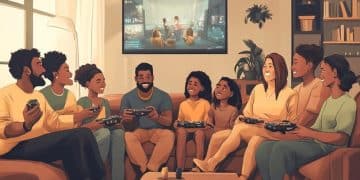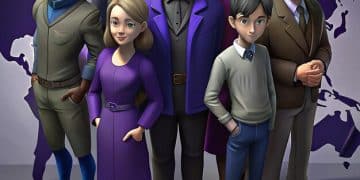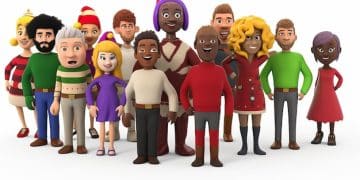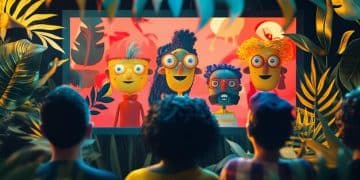The Evolution of Sitcom Humor: From 90s to Modern Comedy Series

The evolution of sitcom humor has shifted from broad, family-friendly narratives in the 1990s to more diverse, edgy, and self-aware comedic styles in today’s comedy series, reflecting societal changes and evolving audience preferences.
The landscape of television comedy has undergone a significant transformation over the past few decades. The Evolution of Sitcom Humor: Tracing the Trends from 1990s to Today’s Comedy Series reveals a fascinating shift in comedic styles, themes, and audience expectations.
The Rise of Family Sitcoms in the 1990s
The 1990s were a golden age for family sitcoms, dominating television screens with their heartwarming stories and relatable characters. These shows often revolved around traditional family structures and explored everyday challenges with a humorous twist.
Defining Characteristics of 90s Family Sitcoms
1990s family sitcoms offered lighthearted entertainment by focusing on feel-good narratives and endearing characters. These shows often served as a comfortable escape for viewers.
Popular Shows and Their Appeal
Shows like “Full House,” “Home Improvement,” and “Family Matters” captured audiences with their wholesome humor and focus on family values. “Friends,” though featuring younger adults, still provided a safe and relatable comedic escape.
- Wholesome Humor: Emphasized clean jokes and lighthearted situations suitable for all ages.
- Focus on Family Values: Reinforced traditional family structures and values.
- Relatable Characters: Featured characters that viewers could easily identify with and root for.
- Feel-Good Narratives: Provided optimistic and uplifting storylines.
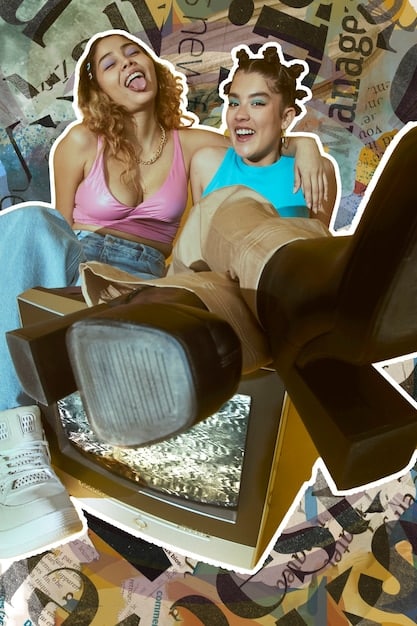
The 1990s sitcoms established a strong foundation for television comedy, setting the stage for future innovations while also showcasing a unique approach to humor and storytelling that continues to resonate with audiences today.
The Emergence of Edgy Humor
As the 2000s approached, sitcoms started to push boundaries and explore more controversial themes. Edgy humor found its way into mainstream television, catering to a changing audience hungry for more daring and unconventional comedy.
Breaking the Mold: Shows That Pushed Boundaries
Shows like “Malcolm in the Middle” and “Arrested Development” challenged the traditional sitcom format with their unique perspectives and unconventional characters. These shows often tackled taboo subjects and used satire to comment on social issues.
Use of Satire and Dark Humor
Satire and dark humor became more prevalent, allowing sitcoms to address complex and often uncomfortable topics with a comedic lens. This shift reflected a broader cultural trend toward more cynical and self-aware comedy.
- Satirical Storylines: Addressing societal issues with comedic exaggeration.
- Taboo Subjects: Exploring previously off-limits topics like dysfunctional families and social anxieties.
- Unconventional Characters: Featuring flawed and morally ambiguous protagonists.
The introduction of edgy humor marked a turning point in sitcom history, paving the way for even more experimental and boundary-pushing comedies in the years to come. Audiences began to embrace shows that challenged their perspectives and offered a more realistic and often darker view of the world.
The Mockumentary Style Takes Over
The mockumentary style, with its documentary-like approach and direct-to-camera interviews, revolutionized sitcoms by creating a sense of realism and intimacy. This format allowed for a more nuanced and character-driven comedy that resonated with audiences.
Key Elements of Mockumentary Sitcoms
Mockumentary sitcoms employ several key elements to enhance the comedic effect. These include direct address to the camera, handheld camera work, and improvised dialogue, all of which contribute to a more authentic and engaging viewing experience.
“The Office” and Its Groundbreaking Impact
“The Office” stands out as a prime example of a mockumentary sitcom that achieved widespread success. Its relatable characters, awkward situations, and cringe-worthy humor made it a cultural phenomenon, influencing countless other shows in the genre. “Parks and Recreation” also successfully used the mockumentary style to create a quirky and endearing portrayal of local government.

- Enhanced Realism: Creates a sense of authenticity that traditional sitcoms often lack.
- Character-Driven Comedy: Allows for deeper exploration of characters’ personalities and motivations.
- Audience Engagement: Draws viewers in by making them feel like they are part of the story.
The mockumentary style has had a lasting impact on sitcoms, providing a fresh and innovative way to tell stories and connect with audiences on a more personal level. Its influence can still be seen in many of today’s top comedy series.
Diversity and Representation in Modern Sitcoms
Modern sitcoms have made significant strides in diversity and representation, reflecting a broader cultural shift toward inclusivity and social awareness. These shows are now more likely to feature characters from diverse backgrounds and address issues of race, gender, and sexuality with sensitivity and humor.
Breaking Stereotypes and Promoting Inclusivity
Many modern sitcoms actively work to break down stereotypes and promote inclusivity by portraying diverse characters in complex and nuanced roles. This approach not only enriches the storytelling but also helps to challenge societal biases and prejudices.
Notable Examples: “Brooklyn Nine-Nine,” “One Day at a Time”
Shows such as “Brooklyn Nine-Nine” and “One Day at a Time” have been praised for their diverse casts and their willingness to tackle social issues with humor and heart. These shows demonstrate the power of sitcoms to entertain and educate audiences simultaneously.
- Diverse Casting: Featuring actors from various ethnic, racial, and cultural backgrounds.
- Complex Characters: Developing characters with depth and multifaceted personalities.
- Social Commentary: Addressing social issues and promoting understanding and empathy.
The increasing focus on diversity and representation has had a profound impact on modern sitcoms, making them more relevant and engaging for a wider range of viewers. As audiences become more diverse, sitcoms must continue to evolve to reflect the world around them.
The Rise of Single-Camera Comedies
Single-camera comedies offer a more cinematic and visually dynamic approach to sitcoms, allowing for greater flexibility in storytelling and character development. This format has become increasingly popular in recent years, with many critically acclaimed and commercially successful shows adopting the style.
The Cinematic Appeal of Single-Camera Sitcoms
Single-camera sitcoms often feature more elaborate sets, location shooting, and sophisticated cinematography, giving them a more polished and visually appealing look compared to traditional multi-camera sitcoms. This cinematic approach allows for richer storytelling and more immersive viewing experiences.
Examples and Their Success: “Modern Family,” “Community”
“Modern Family” and “Community” are prime examples of single-camera comedies that have achieved widespread success. “Modern Family’s” mockumentary style and ensemble cast have made it a long-running favorite, while “Community’s” meta-humor and creative storylines have earned it a loyal cult following.
- Visual Storytelling: Using cinematography and editing to enhance the comedic effect.
- Creative Freedom: Allowing for more experimental and unconventional narratives.
- Character Depth: Providing opportunities for deeper exploration of characters’ lives and relationships.
Single-camera comedies have become a dominant force in the world of sitcoms, offering a fresh and innovative approach to storytelling that appeals to modern audiences. Their cinematic appeal and creative freedom have paved the way for some of the most beloved and critically acclaimed shows of recent years.
Streaming Services and the Binge-Watching Phenomenon
The advent of streaming services like Netflix, Hulu, and Amazon Prime has revolutionized the way people consume television, leading to the rise of binge-watching and a new golden age for sitcoms. These platforms have given creators more freedom to experiment with different formats and styles, resulting in a diverse and innovative landscape of comedy series.
How Streaming Changed Sitcoms
Streaming services have disrupted the traditional television model in several ways. They have eliminated the need for weekly episode releases, allowing viewers to watch entire seasons at their own pace. They have also given creators more creative control, enabling them to take risks and push boundaries that might not have been possible on traditional networks.
Impact on Content Creation and Consumption
The shift to streaming has had a significant impact on both content creation and consumption. Creators are now more focused on crafting cohesive and engaging seasons that can be enjoyed in a single sitting, while viewers have more choice and control over what they watch and when they watch it.
- Creative Freedom: Allows creators to experiment with different formats and styles.
- Binge-Watching: Encourages viewers to consume entire seasons in one sitting.
- Increased Choice: Provides viewers with a vast library of comedy series to choose from.
Streaming services have fundamentally changed the landscape of sitcoms, opening up new possibilities for creators and providing viewers with unprecedented access to high-quality comedy content. As these platforms continue to evolve, they will undoubtedly shape the future of television comedy in exciting and unpredictable ways.
The Future of Sitcom Humor
The future of sitcom humor is likely to be shaped by several factors, including technological advancements, changing audience demographics, and evolving social attitudes. As technology continues to evolve, sitcoms may incorporate more interactive and immersive elements, blurring the lines between entertainment and reality.
Trends Shaping the Future of Comedy
Several trends are poised to influence the future of sitcoms. These include the rise of personalized content, the increasing importance of social media, and the growing demand for diverse and inclusive storytelling. Sitcoms may also become more collaborative, with viewers having a greater say in the direction of storylines and character development.
Predictions and Possibilities
It is difficult to predict exactly what the future holds for sitcom humor, but it is likely to be a dynamic and ever-changing landscape. One possibility is that sitcoms may become more niche-oriented, catering to specific demographics and interests. Another is that they may become more global, with shows from different countries gaining wider audiences through streaming platforms.
- Technological Advancements: Incorporating interactive and immersive elements.
- Social Media Influence: Leveraging social media to engage with viewers and promote shows.
- Personalized Content: Catering to individual tastes and preferences.
The evolution of sitcom humor is an ongoing process, and the future is full of exciting possibilities. As long as there are talented writers, innovative creators, and engaged audiences, sitcoms will continue to entertain, challenge, and reflect the world around us.
| Key Concept | Brief Description |
|---|---|
| 💖 90s Family Sitcoms | Wholesome humor and focus on traditional family values. |
| 🤣 Edgy Humor | Satire and dark humor addressing complex topics. |
| 🎥 Mockumentary Style | Documentary-like approach for realism and engagement. |
| 🌐 Diversity | Increased representation and inclusivity in modern sitcoms. |
Frequently Asked Questions
Sitcom humor in the 1990s was primarily defined by its family-friendly nature, focusing on relatable situations within the context of traditional family structures. Shows emphasized wholesome humor and feel-good narratives.
Edgy humor pushed boundaries, introducing satire and dark comedy to address taboo subjects and social issues. This shift catered to an audience seeking more daring and unconventional comedic styles.
The mockumentary style uses documentary-like elements, such as direct-to-camera interviews and handheld filming, to create a sense of realism. This format allows for character-driven comedy and greater audience engagement.
Diversity in modern sitcoms reflects cultural shifts toward inclusivity, challenging stereotypes and promoting understanding. Diverse casting and complex characters enrich storytelling and resonate with a wider audience.
Streaming services have revolutionized sitcoms by offering creative freedom, encouraging binge-watching, and providing a vast library of content. This has led to innovative formats and increased viewer choice within the comedy genre.
Conclusion
From the wholesome family sitcoms of the 1990s to the edgy, diverse, and technologically advanced comedies of today, the evolution of sitcom humor reflects the changing values, attitudes, and lifestyles of society. Streaming services, single-camera styles, and greater inclusivity have all contributed to a vibrant and dynamic landscape of comedy series.

